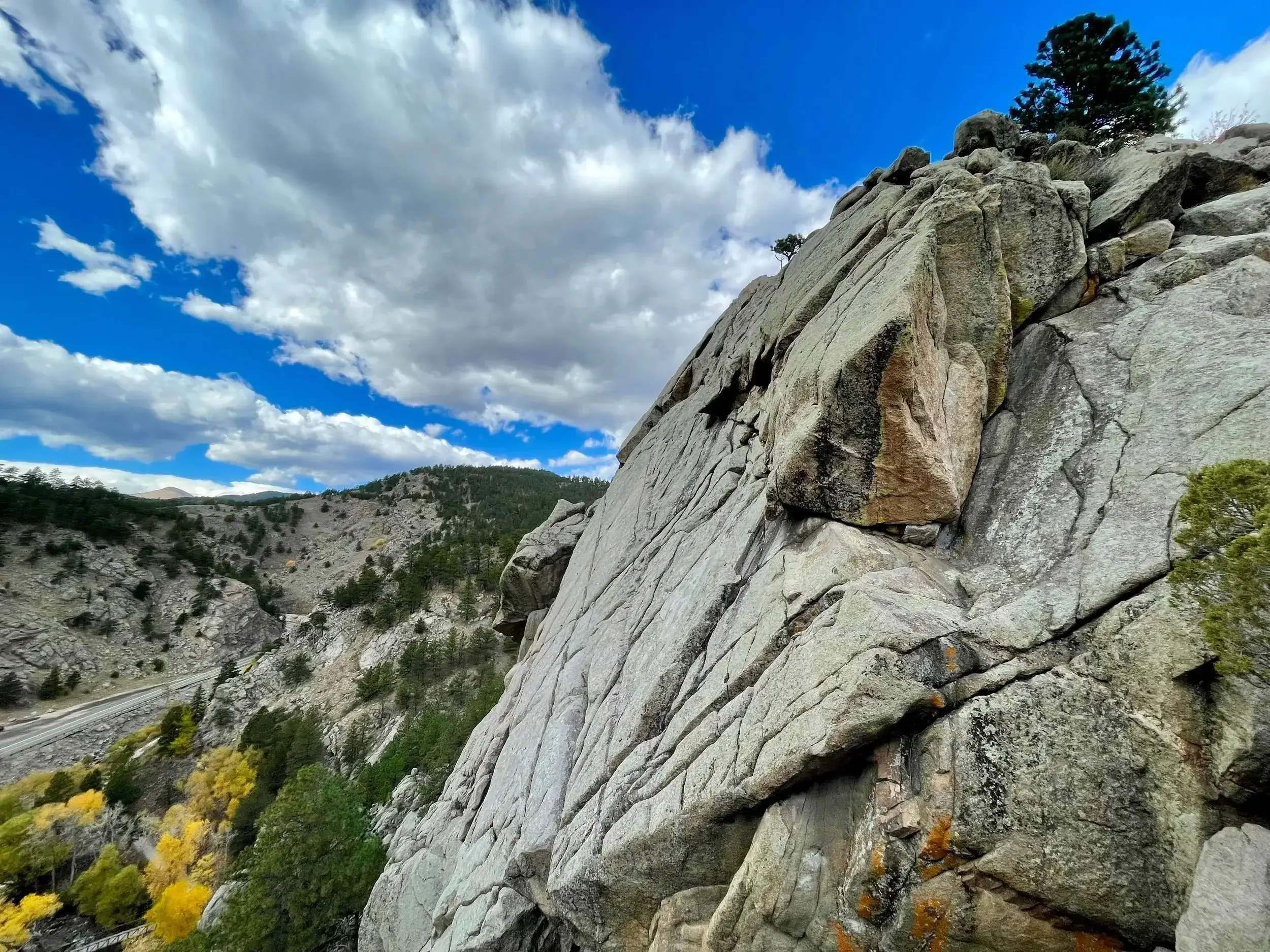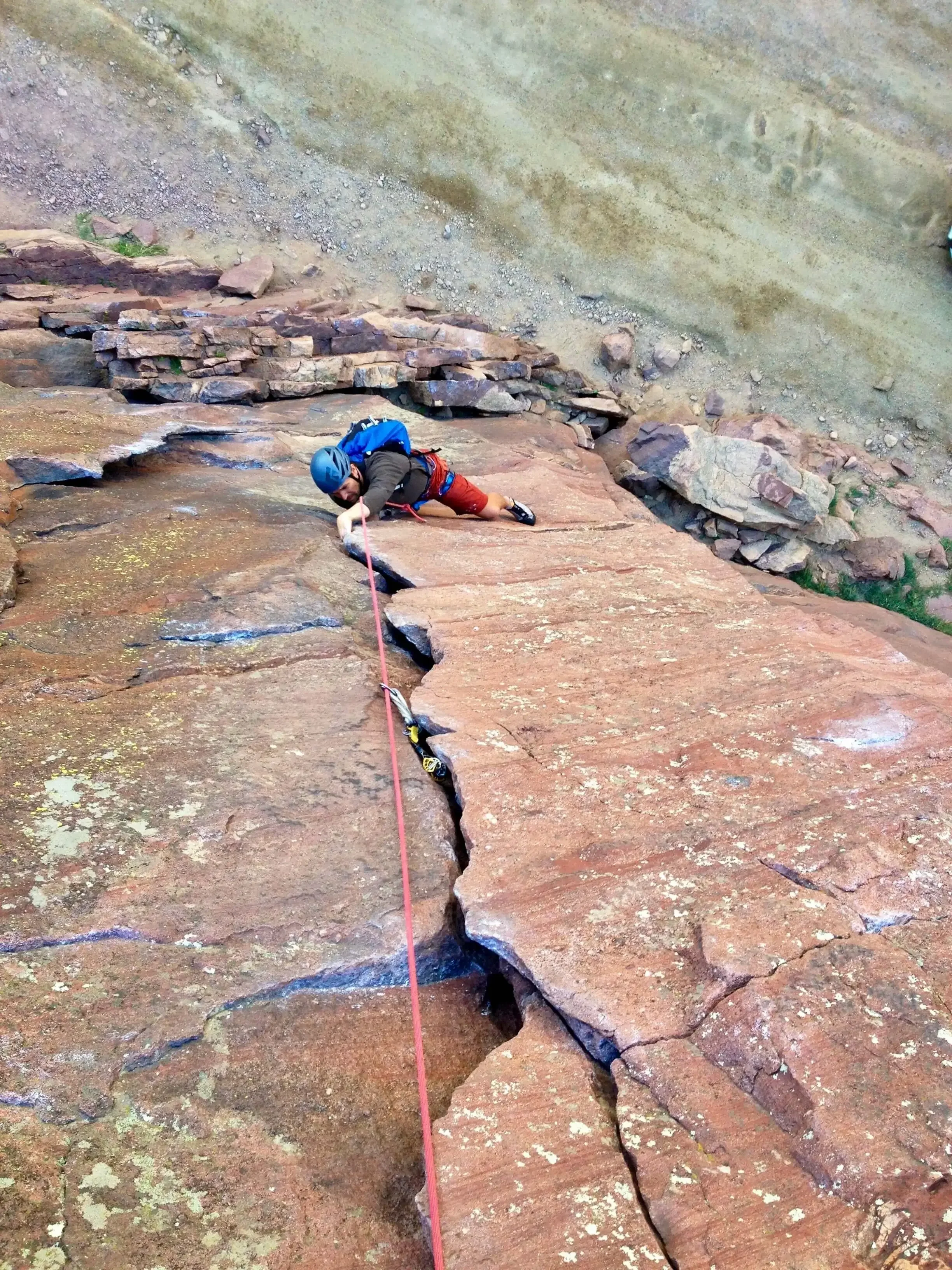
Rock Climbing In Boulder, Colorado
Experience rock climbing in Boulder, Colorado—one of the premier climbing destinations in the country. Boulder, CO is well known for it’s incredible access to diverse terrain, rock climbing styles and beautiful views along the Front Range, with the stunning sandstone slabs of the Flatirons, the dramatic cliffs and classic multipitch routes in Eldorado Canyon, the expansive granite cragging in Boulder Canyon and the unbeatable mountain community vibe in this hip college town. Whether you’re a first-timer or an advanced climber, Skyward Mountaineering tailors each climbing trip in Boulder to your individual skills and goals to help you push your limits, learn new techniques and have fun climbing at this world class destination.

Multi and single pitch rock climbing
Routes range from 5.2 to 5.12
No previous experience is required, with routes for all abilities
Full day (8 hours)
Mid April - Early November
Boulder, Colorado
5,430 ft / 1,650 m
From Multipitch adventures to projecting hard sport routes, Boulder, Colorado is the Perfect Rock Climbing Destination
Skyward Mountaineering offers personalized guided rock climbing trips in the Flatirons, Boulder Canyon, and Lumpy Ridge - some of Colorado’s most iconic and convenient climbing destinations, only a stone’s throw from a major metropolitan hub. Our access to these unique areas and breadth of experience with local, AMGA certified guides guarantee a fun and personalized guided climbing experience on the Front Range.
-
Minutes from downtown, this popular area features hundreds of well protected sport climbs on beautiful granite, ranging from easy slabs to challenging test pieces. Boulder Canyon also boasts traditional routes and multi-pitch climbs in a scenic setting. Boulder Canyon has multiple cliffs spread throughout the canyon, many of the crags are easily accessible with short approaches from the road and some even have fun tyrolean traverses over the river to add spice to the day’s adventure. Some of our favorite rock climbing routes in Boulder Canyon are:
Empor (5.7, 3 pitches)
Cozyhang (5.7+, 3 pitches)
Runaway (5.8, 1 pitch)
Jackson’s Wall Direct (5.9+, 3 pitches)
Athlete’s Feat (5.11-, 3 pitches)
Regular Route (5.11b, 1 pitch)
Empire of the Fenceless (5.12-, 1 pitch)
Joy Ride (5.12b, 1 pitch)
-
The iconic Flatirons stand high over Boulder and offer a stunning array of multi-pitch trad climbing, cutting edge sport routes and easy scrambles to the summits of many of the jagged formations. There is something for everyone here and the Flatirons offer a more adventurous feel due to the longer approaches and wilderness like setting. Here are some of our favorite rock climbing routes in Boulder’s Flatirons:
East Face of the Third Flatiron (5.4, 8 pitches)
Direct Route on the First Flatiron (5.6, 10 pitches)
Satan’s Slab (5.8+, 9 pitches)
East Ridge of the The Maiden (5.10, 5 pitches)
-
Flatirons: The Boulder skyline is dominated by these long sandstone slab climbs. The First, Second and Third Flatiron have several routes on the East Face with mostly moderate climbing, a great introduction to multi-pitch climbing or prep for alpine climbing objectives. The Flatirons also have lots of smaller crags hidden in the forest with great sport and trad climbing, some of which is single pitch toproping and others are classic multi-pitch routes such as The Maiden.
The geology of the Flatirons is a sedimentary conglomerate Fountain Sandstone formation. Originally a horizontal layer, the Flatirons experienced uplift during the formation of the Rocky Mountains 65 million years ago.
Boulder Canyon: A mix of granite trad and sport routes, from short roadside climbs to big multi-pitch adventures. We typically utilize climbing trips in Boulder Canyon for instructional climbing days or to introduce beginner climbers to rock climbing.
Boulder Canyon geology is defined by Precambrian Basement rocks, predominately metamorphic rocks such as gneiss and schist, which were eroded away by Boulder Creek 1.5 billion years ago.
Eldorado Canyon: Classic, steep sandstone walls with intricate crack systems and historic routes. Eldorado Canyon is a special place with hundreds of trad climbing routes, and a surprising number of high quality moderate multi-pitch routes.
Eldorado Canyon is a stunningly beautiful venue for hiking and climbing, with dramatic views of the steep lichen covered red cliffs. The geology there is the same Fountain Sandstone seen in the Flatirons, formed by the Ancient Rockies which eroded away and left a thick sediment pile over 300 million years ago. Around 200 million years later, another uplift event occurred and raised the steep cliffs of Eldorado which were carved out by South Boulder Creek.
Lumpy Ridge: Traditional granite muli-pitch climbing on domes and spires in a high-alpine setting. Lumpy Ridge is in Rocky Mountain National Park, just outside the town of Estes Park. Easily accessible in a day trip from Boulder, the climbing at Lumpy Ridge is a great opportunity to escape the summer heat. The Araphoe tribe called these dramatic 800 ft tall granite domes, Thath-aa-ai-atah which translates to “little lumps”.









Frequently asked questions
Below are answers to common questions about rock climbing in Boulder with Skyward Mountaineering:
-
No, Skyward Mountaineering offers guided outdoor climbing in Boulder for all abilities, from beginners learning belay skills and introductory climbing movement techniques to experienced climbers seeking out challenging ascents on their dream tick list. We’ll match the location and route to your experience level.
The climbing around Boulder is uniquely qualified to offer a wide diversity of difficulty grades, route lengths, and complexities so trust us: there really is a route for everyone!
-
Boulder has a wide diversity of climbing styles, geologic features, lengths and difficulties. One of the many reasons Colorado’s Front Range is such a fantastic venue for outdoor rock climbing and why we love to guide there. There are introductory toprope routes with short approaches, bolted sport climbs of all difficulty levels, long moderate multi-pitch trad climbs, challenging multi-pitch crack climbs, and everything in between.
-
Yes! Skyward Mountaineering puts a lot of value in working with you to personalize every guided climbing trip, so details like the start time, hiking pace, photos, climbing instruction, multiday linkups at a variety of areas, etc. can all be adjusted to meet your specific goals. Your guide will reach out in the days before the trip to discuss these logistics, please let your guide know if you have any questions or specific requests.
Additionally, our administrative staff are climbers and guides too and we’re here to support you through the whole process. If you have any questions before booking your guided climb or before the trip starts please reach out to us and we are happy to answer your questions.
-
We guide at a maximum ratio of 4 climbers per guide for toproping in Boulder Canyon. If you want to climb a multi-pitch route in Lumpy Ridge or the Flatirons, our maximum ratio is 2 climbers per guide. If you have a larger group we can add a second guide to the team to maintain the appropriate ratio for the climbing objective. Contact us to discuss booking a rock climbing trip with larger groups, we’re happy to help your whole team get out and have fun together.
-
We have a detailed equipment list to help you prepare and pack for your trip. If you have questions about any of the gear please let us know, we’re happy to help make recommendations or clarify.
Skyward Mountaineering provides all of the technical group climbing equipment, this includes ropes, anchor material, protection, etc. Many of clients are experienced rock climbers and prefer to use their own equipment, though we do maintain a small amount of personal technical equipment for climbers to use on our trips. Please let the admin staff or your guide know ASAP if you expect to borrow personal climbing equipment such as backpacks, harness, helmet, belay device, carabiners, personal tether, etc.
-
The season for rock climbing in Boulder is…year round! Yes, it’s possible to climb most days of the year in Boulder. The prime seasons are early spring to mid fall. Summers can be hot in the sun but it’s always possible to chase shade at crags in the Flatirons and Boulder Canyon or climb at higher elevations such as at Lumpy Ridge in Estes Park. During the spring and fall, it is easier to climb in either the sun or shade and seek out more comfortable climbing conditions.
-
Our guides closely watch forecasts to have the most up-to-date and accurate conditions. If weather prohibits the team from climbing and your guide deems conditions to be unsafe/unreasonable for climbing we will work with you to reschedule your climbing trip.
For more information on our cancellation policy, please see our terms and conditions and contact us with any other questions.
-
If you know what dates you want to climb in the Flatirons, Boulder Canyon or Lumpy Ridge, you can book your trip directly on our website. You can also get in touch to discuss your goals and ask any questions, we’re happy to help and send you a custom booking.
Though we often have availability for last minute trips, please always reach out and ask, we highly recommend booking your trip at least 2 weeks in advance so we can guarantee your guide’s availability and ensure that you are confirmed with all the logistics.







